|
|
Post by Deleted on Jul 12, 2019 22:33:42 GMT -5
I remember how absurd it was when Marvel did a new KILLRAVEN mini-series, and got Alan Davis to do it. Neal Adams was the original artist on WAR OF THE WORLDS (just-- barely) and Davis has always been Adams-inspired-- in my view, doing Adams better than Adams. But while it was well-done, it was (apparently) NOT part of the established continuity. So... what was the point? (emphasis mine-MRP) I don't really see that KILLRAVEN should be looked on as "tied in" to the main MU. I mean, apart from one issue of MARVEL TEAM-UP, and one issue of THE DEFENDERS... it really should have stood on its own. (Ditto, THE ETERNALS... MASTER OF KUNG FU...) To tell a story that entertained people? To sell comics? If the only reason to do comics is continuity, then they might as well quit-I mean Superman would have had to have had about 120 adventures a day to fit all the Superman stories told since he was created into his continuity lifespan where he is eternally 29... The absolute last reason to do a comic should be continuity. Continuity as such only matters to a small subset of hardcore fans and is relatively inconsequential in the grand scheme of things. -M |
|
|
|
Post by beccabear67 on Jul 12, 2019 22:43:46 GMT -5
Continuity is just a bonus thing for me if I do notice it. Somehow through the no-prizes, letter columns and a certain kind of scholarly critical fanzine review (scholarly about comic book continuity not about a larger context) it got obsessed over to where the only people who could really work on most Marvel or DC comics had to have been massively detail obsessed fans with bound volumes and D&D style handbooks and all of that. How often have we heard though professionals say how some fans know more about the characters and the fictional history than they do? The Doctor Who tv show even had a consultant for continuity and history in the '80s (not that this did it all that much good, the fanzines ended up absolutely hating that producer anyway).
|
|
|
|
Post by EdoBosnar on Jul 13, 2019 4:59:04 GMT -5
I remember how absurd it was when Marvel did a new KILLRAVEN mini-series, and got Alan Davis to do it. Neal Adams was the original artist on WAR OF THE WORLDS (just-- barely) and Davis has always been Adams-inspired-- in my view, doing Adams better than Adams. But while it was well-done, it was (apparently) NOT part of the established continuity. So... what was the point? (emphasis mine-MRP) To tell a story that entertained people? To sell comics? (...) Yep. I bought it. And was entertained. Didn't care that it didn't fit into Killraven's previous continuity (even though I also thoroughly enjoyed the original Killraven run). |
|
|
|
Post by badwolf on Jul 13, 2019 9:41:35 GMT -5
Continuity is just a bonus thing for me if I do notice it. Somehow through the no-prizes, letter columns and a certain kind of scholarly critical fanzine review (scholarly about comic book continuity not about a larger context) it got obsessed over to where the only people who could really work on most Marvel or DC comics had to have been massively detail obsessed fans with bound volumes and D&D style handbooks and all of that. How often have we heard though professionals say how some fans know more about the characters and the fictional history than they do? The Doctor Who tv show even had a consultant for continuity and history in the '80s (not that this did it all that much good, the fanzines ended up absolutely hating that producer anyway). I think the current series of DW got around the issue of continuity gaffes by stating that time travel is always causing little shifts here and there. |
|
|
|
Post by profh0011 on Jul 13, 2019 12:44:26 GMT -5
To tell a story that entertained people? To sell comics? If the only reason to do comics is continuity, then they might as well quit Ah but, here's the thing... early-on, WOTW was one of those multitude of editor-mandated new series that NOBODY apparently gave a S*** about, not even the big-name artist recruited to do it.
On his FB page, Don McGregor talked about how decades after-the-fact, he was shocked to find out that "editorial" held him and his work in contempt-- that the only reason he was assigned to do BLACK PANTHER and KILLRAVEN was because it was felt they had NO chance of success... and that once Don failed, he could then be told, "Oh, well, we gave you a shot."
Except they didn't fail. Don poured his heart and soul into those series... and "editorial" got very annoyed when Don started getting more fan mail than most of Marvel's other books put together.
Several years after AMAZING ADVENTURES was eventually cancelled... McGregor & Russell were reunited to do the KILLRAVEN graphic novel. It picked up exactly where the series had left off, moved "the big story" along, and set things up for one more BIG story, that would be the grand finale to bring "the big story" to a CONCLUSION.
Except it never happened.
Over the decades, I've consistently been annoyed at "big stories" that are NEVER finished. Like CAPTAIN SCARLET AND THE MYSTERONS, UFO, SPACE: 1999, BATTLESTAR GALACTICA, TERRAHAWKS, V, and so on.
I think at least part of why series like THE FUGITIVE and THE PRISONER are so well-loved is because they DID bother to finish their "big story". Ditto for STAR BLAZERS, where they finished their first big story in 26 episodes... then, 4 years later, told a 2nd "big story", which they also finished in 26 episodes.
Don & Craig's KILLRAVEN deserved to be finished. Marvel editorial are IDIOTS for never, ever doing so.
And that Alan Davis mini was just POINTLESS... no matter how nice it looked.
|
|
|
|
Post by codystarbuck on Jul 14, 2019 16:37:02 GMT -5
Marvel Preview #9 Finally, Titan! Er...........Man-God! Really nice Earl Norem cover! Creative Team: Phillip Wylie-writer, Roy Thomas-adaptor, Tony DeZuniga-art. Roy edits himself, Archie Goodwin & John Warner-consulting editors. Rich Buckler was originally part of this and is listed on the contents page; but, not on story pages. Buckler was supposed to be the artist, when this was conceived, but dropped out somewhere along the way. Don & Maggie Thompson provide text articles about Phillip Wylie and supermen, in science fiction. Don Thompson and Richard Lupoff worked together on the seminal Xero fanzine, whose articles would form the historical pieces featured in the books All In Color For A Dime and The Comic Book Book. Don & Maggie were part of early fandom and produced Harbinger, a sci-fi and comic fanzine and were columnists for Alan Light's The Buyer's Guide to Comics Fandom (laterthe Comic Buyer's Guide). Light sold the publication to Krause and the Thompsons became joint editors. Maggie continued as editor, after Don's death, until the end of the publication. Her son Stephen was an editor with the Onion and founder of The AV Club, as well as host of the Pop Culture Happy Hour, on NPR. Maggie appeared frequently on the show and is a mentor to NPR contributor Glen Weldon. Maggie's mother was Betsy Curtis, a noted sci-fi author, who was nominated for a Hugo for the story, "The Steiger effect," and who had longtime correspondences with Robert Heinlein and L Ron Hubbard. So, pretty good pedigrees on this one. Synopsis: 1914. On a ship nearing the port of Marseilles, an officer speaks to a passenger about an American cewman, who is swabbing the deck. He got on in Panama and worked his way across. Something about him suggests power. Just then, a woman cries out that her son has fallen overboard and there is a shark circling, in the water (not unknown; but, not that common). The American dives in and swims to the child. The shark attacks and the American fights it.... 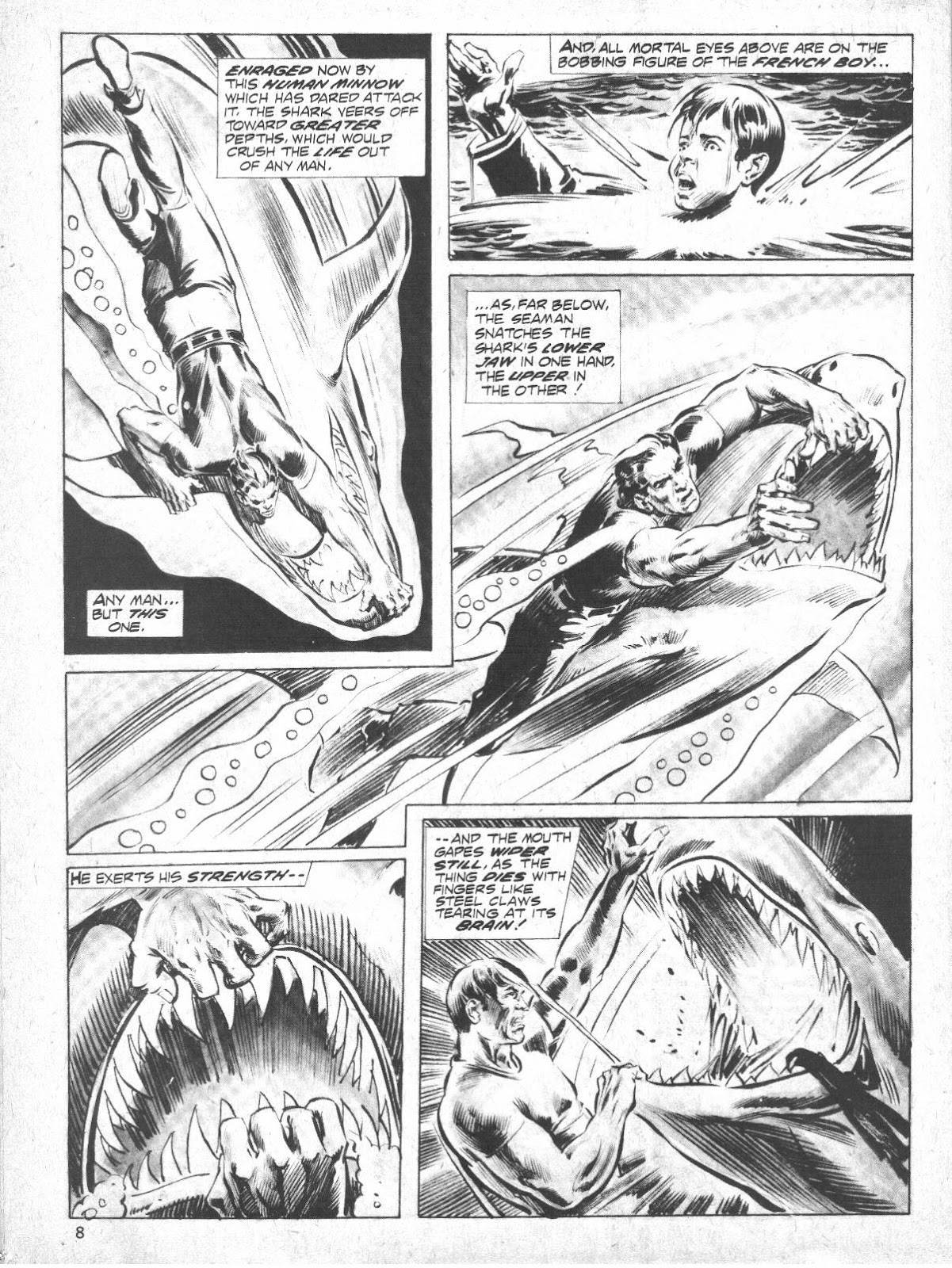 The American rescues the child and brings him back aboard. he tells a lie about a spot to hit a shark's jaw to break it. he departs the ship and the questioner follows, catching up with him at a restaurant. he introduces himself as a fellow American, Thomas Shayne, from New York. The hero tries to beg off but gives in to Shayne's request to join him. There is a silence between them, which is broken by news of the outbreak of war. The hero's French is minimal and Shayne translates for him. The hero, Hug Danner, is overcome by a bloodlust and a desire to fight, and decides to join the French foreign Legion. he convinces Shayne, an adventurer to do so, as well. They go sign up and then leave the recruitment offices, where they are attacked by thugs, looking to steal their enlistment bonus. Danner fights them off single-handedly, disguising his great strength and hiding from Shayne that a knife broke on his chest. The men get drunk and pass the time talking, though Danner gives few specifics about his life. They say goodnight and go to bed, for they become Legionnaires in the morning. Hugo reflects back on his life, as we see his father Abednego Danner, a biology professor, who experimented with alkalines in the blood. he isolated a serum that he tested on a cat, which became a terror to larger livestock in the area. Bullets did not pierce its skin and Danner was forced to kill it with poison. he swore off his experiments; but, could not resist the chance, when his wife became pregnant. he secretly drugged her and injected the fetus with his serum. She gave birth to a very healthy Hugo. Hugo's mother soon learns what happened, when she is unable to lift Hugo, as he won't allow it. She curses her husband for his experiments, but accepts it. Hugo is soon able to bend the bars of his crib and lift a sofa one-handed. he consumes more food in a meal than his parent in a week. He goes off to school, counseled to hide his abilities; but, his parents live in fear. 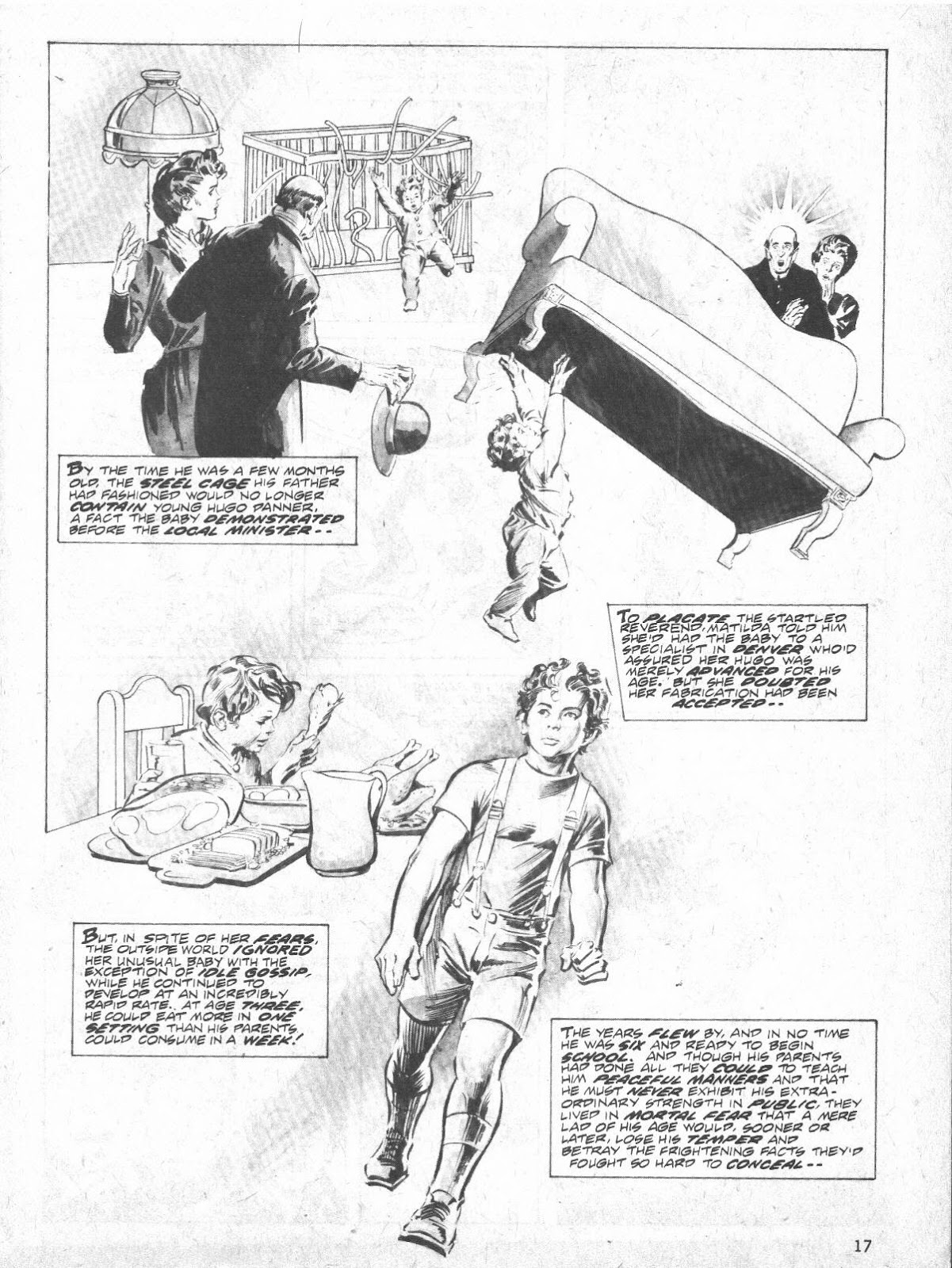 At school, a larger boy, who has heard stories about Hugo, challenges him to a fight and Hugo defends himself, lifting the boy over his head and throwing him, breaking his arm. Hugo is frightened by what he has done and the others see him as a monster, not a hero who stood up to a bully. he becomes an isolated child, smashing trees in the wood, testing his strength. He eventually shows his father, leaping high in the air and lifting massive boulders. His father tells him he is wise to hide it. Hugo eventually goes off to college, and is recruited to the football team. it goes the season undefeated, with Hugo the star. he is introduced to Iris and promises to win the final game for her. He does and receives a note to meet her, at her hotel. 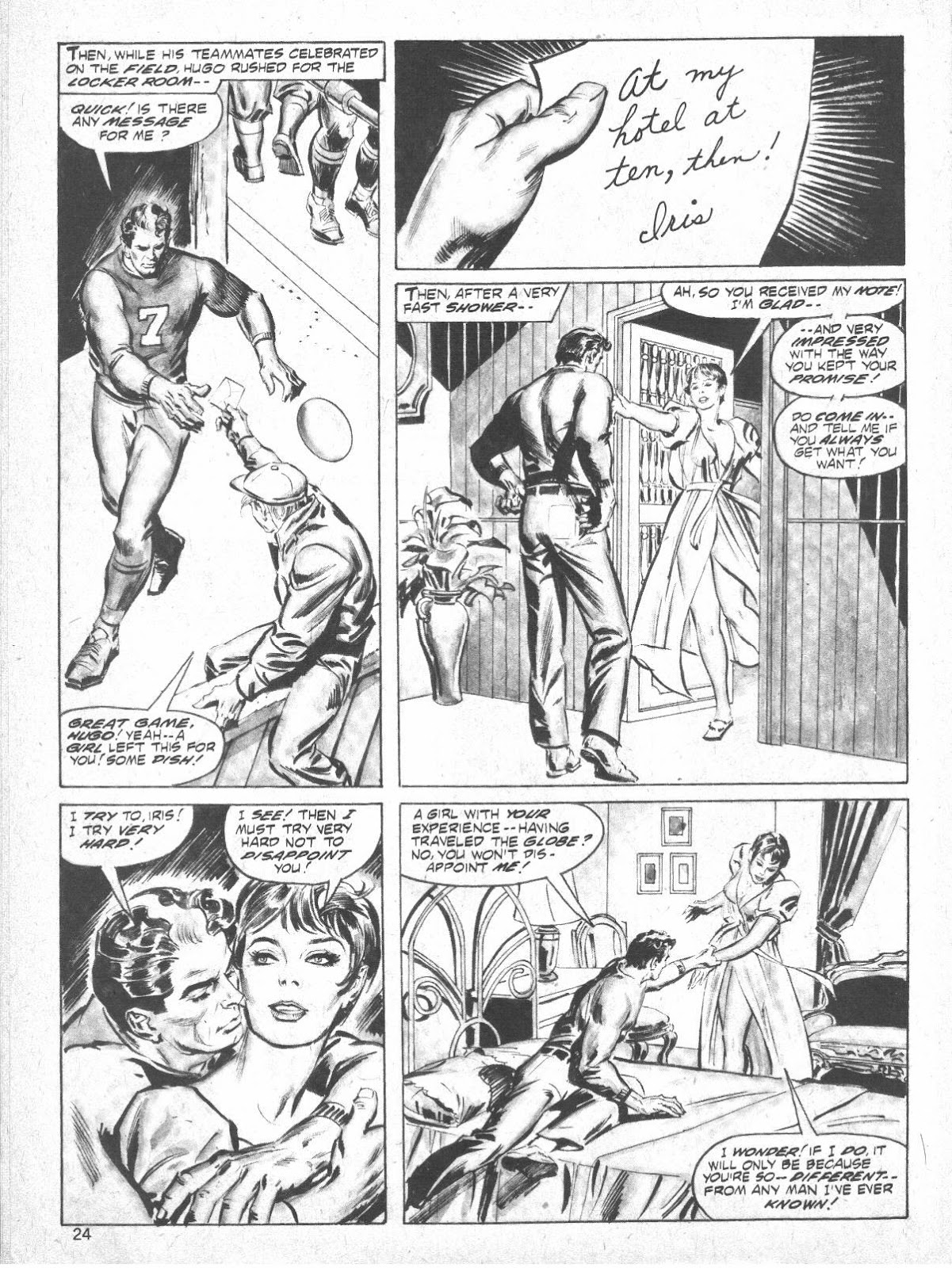 The next morning, iris finds that Hugo is like all men and has left her without saying goodbye, though she rationalizes him away as a bit of fun that would grow tiresome with familiarity. Jeepers, Miss Lane never did that! Hugo receives a letter from his father; they are bankrupt and Hugo will have to leave school or find a job. his fraternity brothers take him to New York to party and he gets drunk and is picked up by a hooker. She takes him to a sleazy hotel, where the do the horizontal mambo and she steals the money from his wallet. he wakes up penniless and alone and wanders the city. he burns with hunger and starts to bend the security bars on a jewelry store to steal something, to get money for food. His conscious overcomes him and he restores the bars, just before a policeman accosts him. he moves along and hops a train to Coney island, where he wanders near an "At Show" (athletic show) where boxers and wrestlers put on an exhibition and then challenge all comers. The barker says a man can win $50 for lasting three rounds or $100 for knocking out the Battling Swede. Hugo takes him up on it. He isn't quite certain whether to hid his strength and go for $50 or for the knockout. He loses control in the fight and knocks the massive Swede out of the ring with a single punch, putting him out cold. He turns down the carnival promoter's offer of a job and moves on.  Hugo later meets a woman, Charlotte, at a bar. She picks him up, in exchange for a meal and then brings him home. She's a new lady of negotiable affection and Hugo falls for her. he moves in and takes care of her, in exchange for her giving up the game. He becomes the strongman for the At Show, with padding to make him look more muscular. He befriends the painter who creates the advertising murals and the trio have a good time, as Hugo carries horses on his back. Charlotte becomes his assistant and Hugo has a reunion with his old college buddies, and Iris. he goes off with them and both Charlotte and Valentine (the painter) realize that he will never stay. They dump him first and Charlotte leaves with Valentine, leaving notes for Hugo. Hugo returns to college and the football team. During a game, he forgets himself, stiffarms a charging tackle and snaps his neck. All are horrified; bu, none more than Hugo... 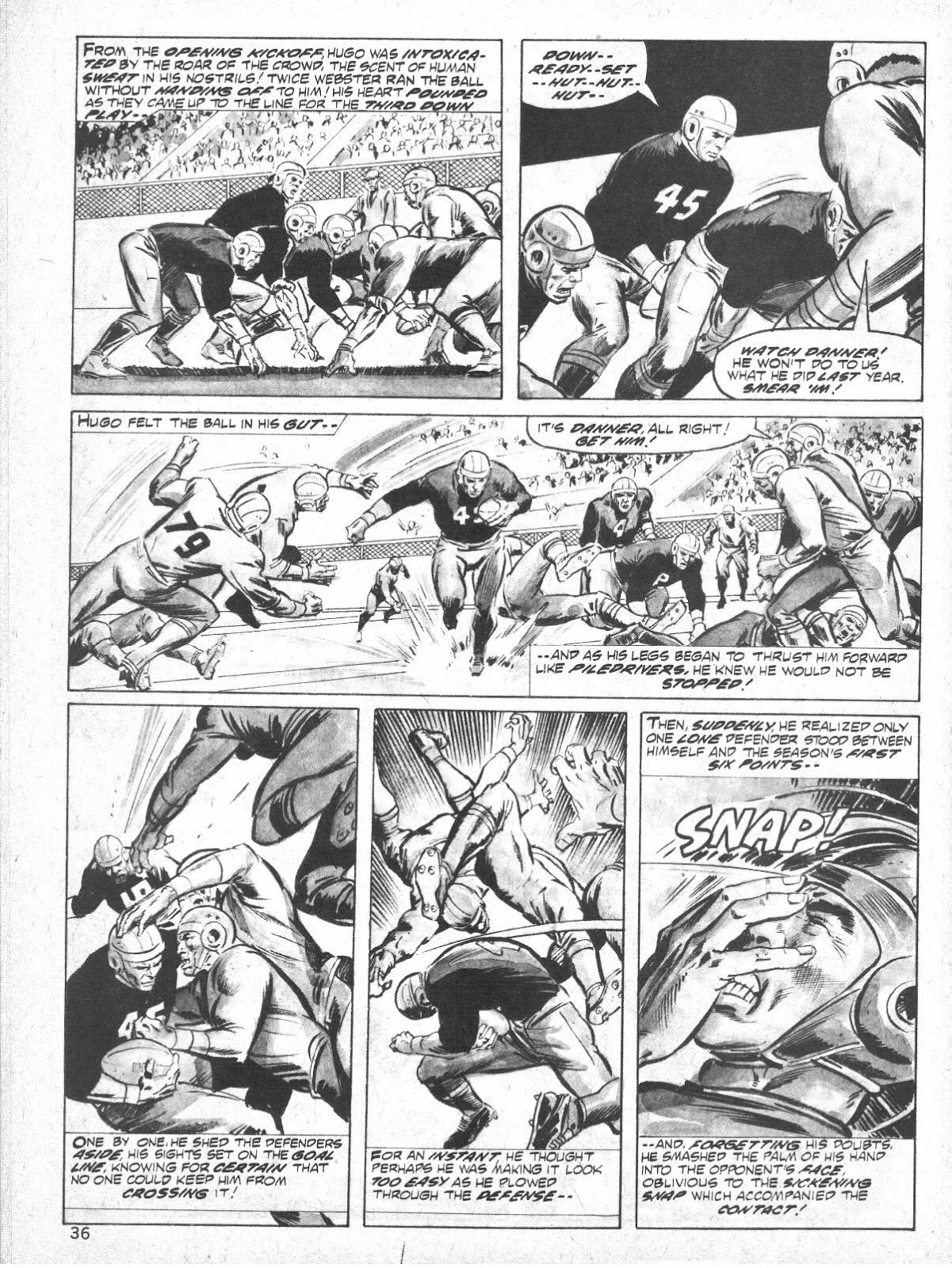 Hugo smashes up the locker room in grief and anger, then leaves. he drifts around, leading us back to the beginning of the story. he and Thomas go off to the Legion and training, where Hugo excels. he chafes for real combat and is rewarded. His unit is ordered to engage the enemy. However, he is stuck manning a machine gun position. His fellow soldiers go down and artillery rains down on them. A charge is mowed down by German machine guns. Hugo is ripped by a burst, yet shrugs it off. he loses control and leaps to the machine gun position and kills the gunners with his bare hand! he then lays waste to the German lines... 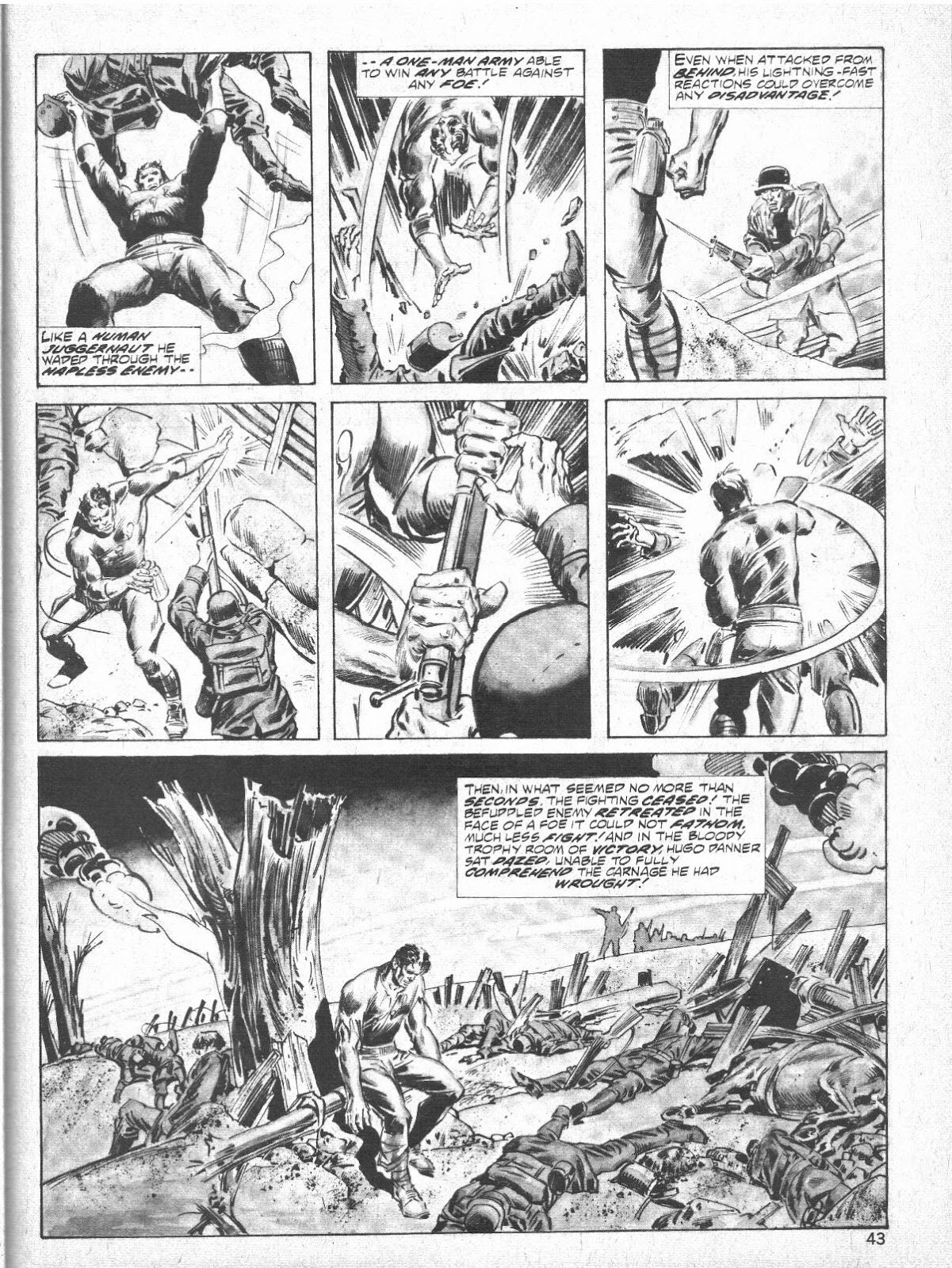 Hugo's unit is out of ammo when the Germans counter-attack. he goes off to bring back some and miraculously does. He shares his secret and his CO alerts his superiors. Hugo puts on a demonstration and is sent back to face the germans and lead the charge. Thomas has been hit but is more sickened by the carnage. Hugo leads a charge and his friends are hit. He goes bezerk and tears up the Germans... He returns to his lines, ready to fight again, before collapsing from the mental strain. he awakens in hospital, where he emets Thomas' parents and tells them that he was a fine soldier. He goes off to fight the Germans again, planning on taking a plane and parachuting into Berlin, to smash the place. A nurse cries out; the war is over and Hugo is relieved. Thoughts: Engaging adaptation of Phillip Wylie' seminal novel, Gladiator, which was an inspiration for Jerry Siegel (as was Wylie's When Worlds Collide). Thomas tells the story in a different fashion than Wylie, as it is a linear story. the over-arching theme is that Hugo Danner's abilities make him an outcast, forever moving on, when the truth is revealed. His power is a curse. Siegel and Shuster flipped this into a benefit, when they created Superman. Hugo's powers are identical to the early Superman stories: bullets bounce off, he can tear through steal, leap for miles, yet he is vulnerable to poison and other things. Wylie was a writer with a dim view of humanity and was noted for his social criticism, in general fiction and essays, and in the themes of his science fiction. His book, Generation of Vipers, was filled with social criticism, attacking mothers, as a group, as well as religion, medicine and politicians. His attacks on mothers were startling. He wrote by dictating his works to a typist and once dicted a 100,000 word piece on a 9-day trip across the Atlantic. Don & Maggie Thompson cover this in their biographical piece and also bring up the tidbit that the murder of Wylie's niece and roommate, in New York, led to a forced confession by a suspect, and the eventual uncovering of the real killer, who confessed. This became the basis for a tv movie: The Marcus-Nelson Murders, which served as a pilot fo Kojak. The Thompson's follow with a piece about the antecedents to both Hugo Danner and Superman, including the figures of myth, A E Van Vogt's Null-A series and Slan, SJ Byrne's Colossus, Jonathan Swift's Gulliver's Travels, Stevenson's Jekyll and Hyde, Wells' Food of the Gods, Burroughs John Carter, etc. Roy would return to Hugo Danner, in Young All-Stars, where he introduced Iron Munro, the son of Hugo Danner. Arn Munro has the same streak of white in his hair that we see on Hugo, in this. This is only part one of the story, which was long delayed, due to Roy's other work and the editorial chaos at Marvel. It's still not finished. Part two never appeared and Young All-Stars ended up being an unofficial sequel, via Arn Munro's backstory. Gladiator would be adapted again, as Legend, at Wildstorm/Image, by Howard Chaykin and Russ heath, though Chaykin moved the time frame up to Vietnam. The original novel sees Danner return home after the war and become a banker. A man becomes trapped in a vault and Danner frees him, in secret, but is treated with suspicion. He moves on, trying politics, then joins an expedition to research the Mayans. He confides in an archeologist, who offers advice. A troubled Danner climbs to the top of a mountain and rails at the heavens about his curse and is struck dead by a lightning bolt. To say it is a disappointing ending is an understatement! The novel is worth reading, in that it presents a less heroic side of the idea of super powers and presents an interesting character, in Hugo Danner. the tragic nature is in sharp contrast with American ideas of the Big Man on Campus and sports hero, war heroes, and the comic book superheroes spawned by the novel. Thomas does an excellent job with the material and is surprisingly adult with it, taking advantage of the lack of Code approval. Dezuniga captures things well, though he is not great with the time frame, until the obvious WW1 scenes. One suspects he found WW1 reference readily; but, not as much about the Turn-of-the-Century. Women aren't exactly depicted well in this. Hugo's mother is barely a figure and is mostly an unwitting victim (not surprising, given Wylie's views on mothers). The rest are portrayed as prostitutes, who want something from Hugo, either money, protection, or a good time. Part of that is period, part is Wylie. Roy seems to soften it a bit, with Charlotte (it's been long enough that I can't recall her in the book). Well worth the wait; but frustrating in its unfinished story.
|
|
|
|
Post by rberman on Jul 14, 2019 17:43:14 GMT -5
Interesting pedigrees indeed!
Was all the bed-hopping part of the original story? Seems unsual for the era.
|
|
|
|
Post by codystarbuck on Jul 14, 2019 18:09:44 GMT -5
Marvel Graphic Novel #3-Dreadstar This begins in Epic Illustrated, with Jim Starlin's Metamorphosis Odyssey. Shaxper covered it, here. To summarize, Two warring alien races hold the fate of the galaxy in their hands. One is the progenitor of all humanoid life, while the other conquers and destroys life. A plan is hatched to save the galaxy from destruction, with seeds planted on different worlds. One of these seeds is the warrior, Vanth Dreadstar. The next part was the graphic novel, The Price, published by Eclipse, which told the tale of Syzygy Darklock, a priest of the Church of the Instrumentality. The Dreadstar graphic novel follows. Starlin owned this material and it became the first creator-owned work published at Marvel, in Epic Illustrated. It would also become the first to move to another publisher. Creative Team: Jim Starlin-everything but the letters, Tom Orzechowski-guess?, Archie Goodwin & Jo Duffy-edits. Steve Englehart writes an introduction, which credits Starlin as the creator of Shang-Chi, taking credit, himself, only for the name. Synopsis: Vanth Dreadstar is on the planet Caldor, where he has abandoned his ice sword and his war, when he fell down, weak. His unconscious form is found by cat people, from a farm community. he is taken to Delilah, a human scientist, for care. 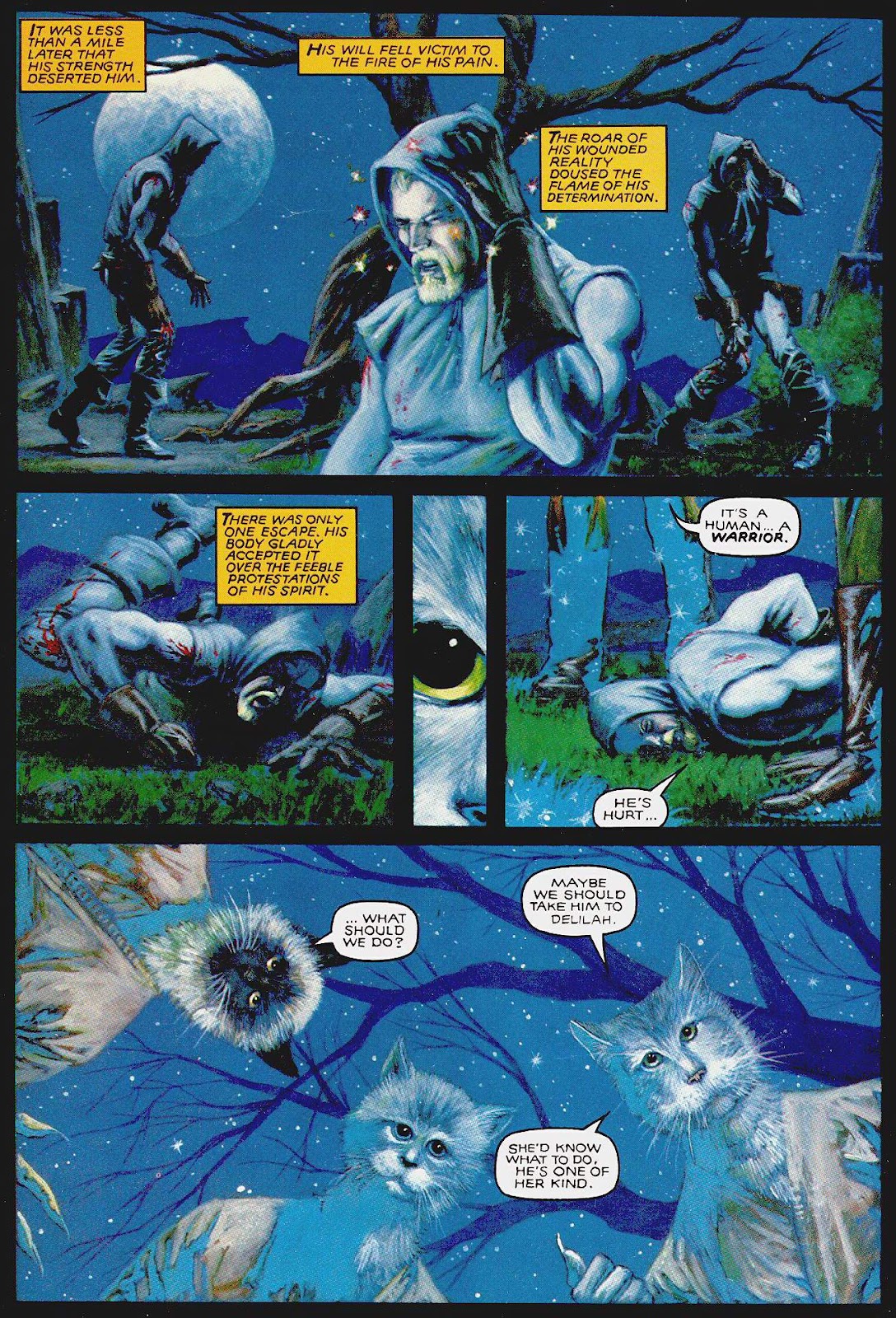 Vanth grows stronger and contributes to the community and grows closer to Delilah. She tells him of the Instrumentality...  The Monarchy and the Instrumentality fight an endless war, because their economies are so tied up in it, an end would destroy them (sounds like a bit of commentary). The cat people are the byproduct of experiments to create the perfect warriors, which backfired. Delilah and her husband came to study them. her husband is gone. Vanth is here. Do the math. Vanth knows peace and love, but is troubled by dreams of his abandoned sword. Eventually, he is made aware, by The people, of another humanoid. he is shown him,; it is Syzygy Darklock. They come together and Darlock says he has been seeking Dreadstar. he speaks in absolutes, as if he knows the future. he says he will be Dreadstar's mentor and speaks of the sword. Dreadstar is uneasy. He should probably read his Mallory to see how this is likely to turn out. Vanth meets up with Darklock, who tells him the time draws near and that he must take up the sword again. the swords has given him immortality and his time with delilah will be brief, at best. Much summarizing of the Metamorphosis Odyssey follows and Vanth rejects it, tired of fighting and killing and the deaths on his hands and conscience. he rejects Darklock and leaves. As he departs, he sees Monarchy ships of the village. Call to arms, my friend; call to arms. As you can guess, Vanth finds death and ruins and what appears to be a crucified Delilah. Sword appears, he finds a Monarchy pilot, and interrogates him. They came for the cat warriors and had orders to kill all scientists. Well the cats aren't warriors and he killed the wrong scientist. Vanth kills him, then heads for the squadron, then the Monarch. Darklock advises him to ignore vengeance and Vanth metaphorically gives him the finger. he's off to enlist. darklock pleads for him not to join the Instrumentality, who he says is muy evil. Dreadstar answers he isn't joining them; he's joining the Monarchy. You know, death from within. Vanth is a success in the Monarchy military and is posted to the Royal Palace, where he proceeds to kill the ruler. He then appears before the prince and gives him some new advice... 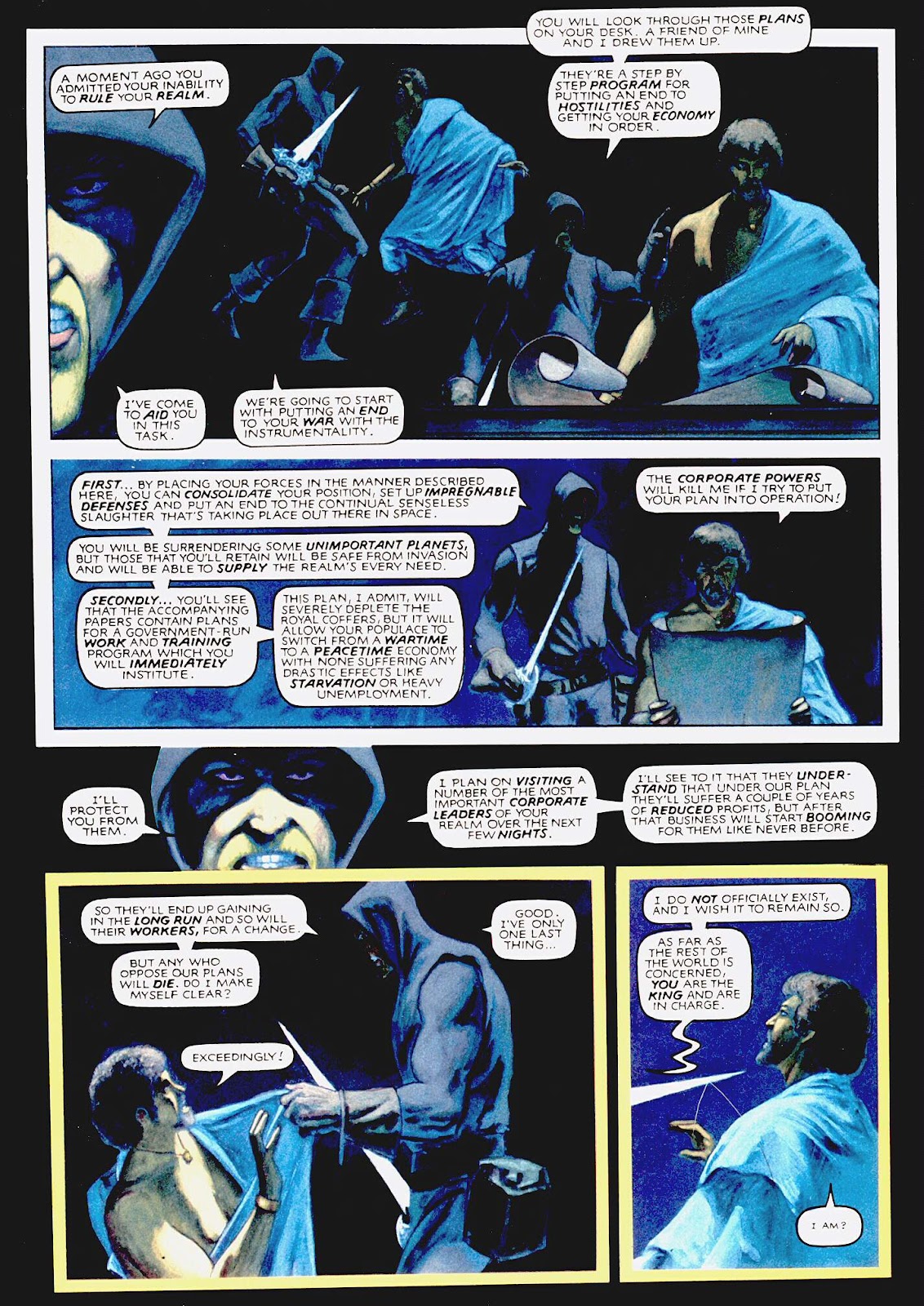 Dreadstar meets up with Darklock and lets him know the plan was a success. now, they face the Instrumentality, who are a different kettle of fish. Thoughts: Starlin was playing at big things, in these early parts to the saga. metamorphosis Odyssey dealt with great alien powers and and end to all, with heroic warriors and magic swords. It basically mined everything from mythology, to Arthurian lore, to Moorcock and Kirby. It also borrows heavily from EE Smith's lensman saga, where two alien races have been at war and use lesser races as pawns in the battle. They create the Lensmen and the Boskone pirates, with a legendary warrior, Kim Kinnison, set to lead the Lensman against the Boskone and their masters. the Kinnison family will be at the heart of the galaxy. Lucas swiped from it, Frank herbert had similar elements in Dune and Starlin is borrowing, too. The Instrumentality is Starlin's critique of the Church, as an organization, as seen in Warlock, writ larger. It is hierarchy as power, at the expense of philosophy or life. This chapter represents a critique of post-WW2 America and the never-ending Cold War, which came to an end a decade later. However, the forces that drove it still drive society, as the Military-Industrial-Congressional Complex (as Eisenhower originally dubbed it, before being persuaded to erase the Congressional part of it) still drives the engine of the nation. There is a constant need for bogeymen to justify massive expenditures on defense and tools of killing, instead of turning that money on improving the human condition. Guns or butter, the endless question. Vanth is a warrior who has seen much death and destruction and when it calls again, he formulates a new attack plan; but, a more subtle one. Rather than fight the soldiers, he goes for the head. Thi sets the stage for moving forward, to dismantle the Church side of the equation, after hitting the State. Starlin's work has always been wrapped up in Church and State, and the Vietnam War. Starlin was a naval photographer, serving during the Vietnam War. He worked in a naval intelligence unit, pouring over rolls of aerial photos of bombing runs, which affected how he perceived his time in service and how the war was portrayed at home. The church aspect came from parochial schooling, with nuns he describes as "Card-carrying members of the John Birch Society." Both of these influences loom large over Starlin's work and especially this. Like The Dreaming City, this is worthy of the album format, as Starlin is painting the art, rather than using line art. As such, the larger format gives better representation of the medium, though the reproduction is nowhere enars as good as a mainstream book or magazine publisher would have given it. Comic book economies still mar the experimentation in the field. Some of this ends up a bit murky, the same issue that plagued Kirby's collages and experiments by Steranko and Chaykin. Comics got better, though still tended to go cheap, where the mainstream publishing would grow bolder. So, with 3 installments, the Marvel Graphic Novel line has given us a superhero story (a damn good one and a more mature one; but, not that far from the normal Marvel story) and two that originated with Epic and Archie Goodwin (well, Star*Reach and Mike friedrich, for Elric). However, Archie isn't running the line. He's busy with Epic, trying to do things that Marvel won't, under the house banner. Shooter would be happier to do more things like The Death of Captain Marvel; but, Starlin is a rarity, at Marvel, at this point. So, our next installment gives us a look at the future of this line, as we launch a new series, with a doube-sized first issue. Will it justify the format or will it need the format to make it seem special?
|
|
|
|
Post by codystarbuck on Jul 14, 2019 18:32:21 GMT -5
Interesting pedigrees indeed! Was all the bed-hopping part of the original story? Seems unsual for the era. I don't recall it; but, it's been about 15 years since I read the novel and I only read it once. I pulled up the project Gutenberg edition of it and it's there, though not especially explicit. Danner goes home with the women; but things end with them going into an apartment or room and pick up after. iris is described as meeting him in a sheer kimono. It says "She taught him a great many things that night." he has a relationship with the daughter of a professor and nearly proposes. The bit with the prostitute, who robs him is there, though, again, not explicit. The part about Charlotte being an amateur "tart" (as that is the word used in the novel) is also there. Roy is pretty faithful to the original text. Wylie's writing isn't very deep in these areas. It's more a facet of his alienation from others. Roy and Dezuniga give it a bit more life. Wylie is probably more known for his influential nature than the quality of his writing. His ideas are stronger than his prose. Burroughs is far more exciting and Siegel & Shuster saw something more positive in the idea of a superman. Wylie is very much a "Glass is half empty" kind of guy, which is ironic, coming from me. Wells always struck me a bit of the same way, though he at least offered alternatives, in his critiques. i'd rather read Verne, who at least revelled in the adventure of things. |
|
|
|
Post by mikelmidnight on Jul 15, 2019 12:05:50 GMT -5
I know reading the original novel you keep wanting to bitchslap him and tell him to put on a union suit to fight crime and develop a mild-mannered demeanor for his personal life.
"Just wait a couple years, and there will be other folks like you to pal around with, too."
|
|
|
|
Post by codystarbuck on Jul 20, 2019 17:35:51 GMT -5
Marvel Preview #10 About damn time! Creative Team: Thor- Len Wein-writer, Jim Starlin-pencils, Tony Dezuniga-inks; Hercules- Bill Mantlo-writer, Val Mayerik-art; John Warner-edits, Len Wein and Roy Thomas-consulting editors. Long delay in this one, as it was originally announced for issue #2. Then came a bit of editorial turmoil and it was delayed for a bit. The question now is, was it worth the wait? Synopsis: Thor and the Warriors Three engage in a brawl, in days of yore (mama). Thor is summed to Odin, who sends his son out with half brother Loki,to secure the Crystal of Blood, before Edda the Elder can get it and destroy Odin. So, break out your Eddas and your Tolkien collection; it's questing time.  They go off to see the sorceress, Shamballa (cue up your Three Dog Night). She treats them to dinner and we answer the question of "How does your light shine in the halls of Shambala?" Answer: it kind of flickers, as it is all candlelight and a fire in a hearth. They dine on venison and honey and sour milk and other viking food, while Thor asks for aid. Shammie says sure. That night, Thor is restless and Shammie shows up to see if Thor really is a God of Thunder, when Loki interrupts things with a cry for help. Thor bursts into his room and finds creatures trying to drag him down into the world below. HAMMER TIME!!! Thor cleans house and Shammie gives up the 411, saying she would have never sold Thor to the gnomes. He and Loki ride off and end up at either Castle Greyskull or Skull Cave... 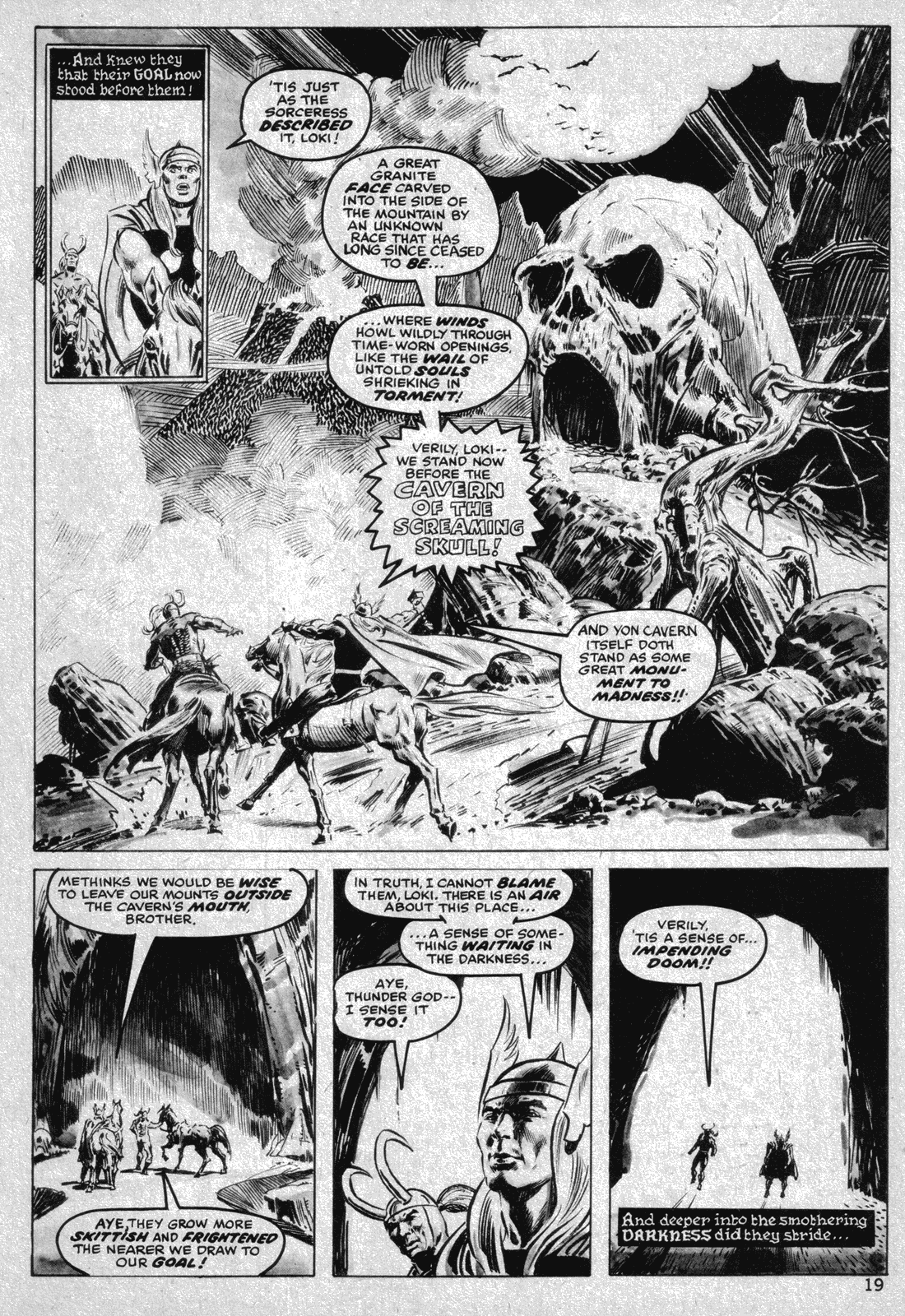 They find some really big dudes, frozen like statues. Thor, mister subtlety, smashes a door and wakes the Titans and it's HAMMER TIME!!!!!!!!!!!! Their fighting wakes up Smaug, who has a Titan snack. Thor tries to hammer it and gets munched; but, kills it from inside... 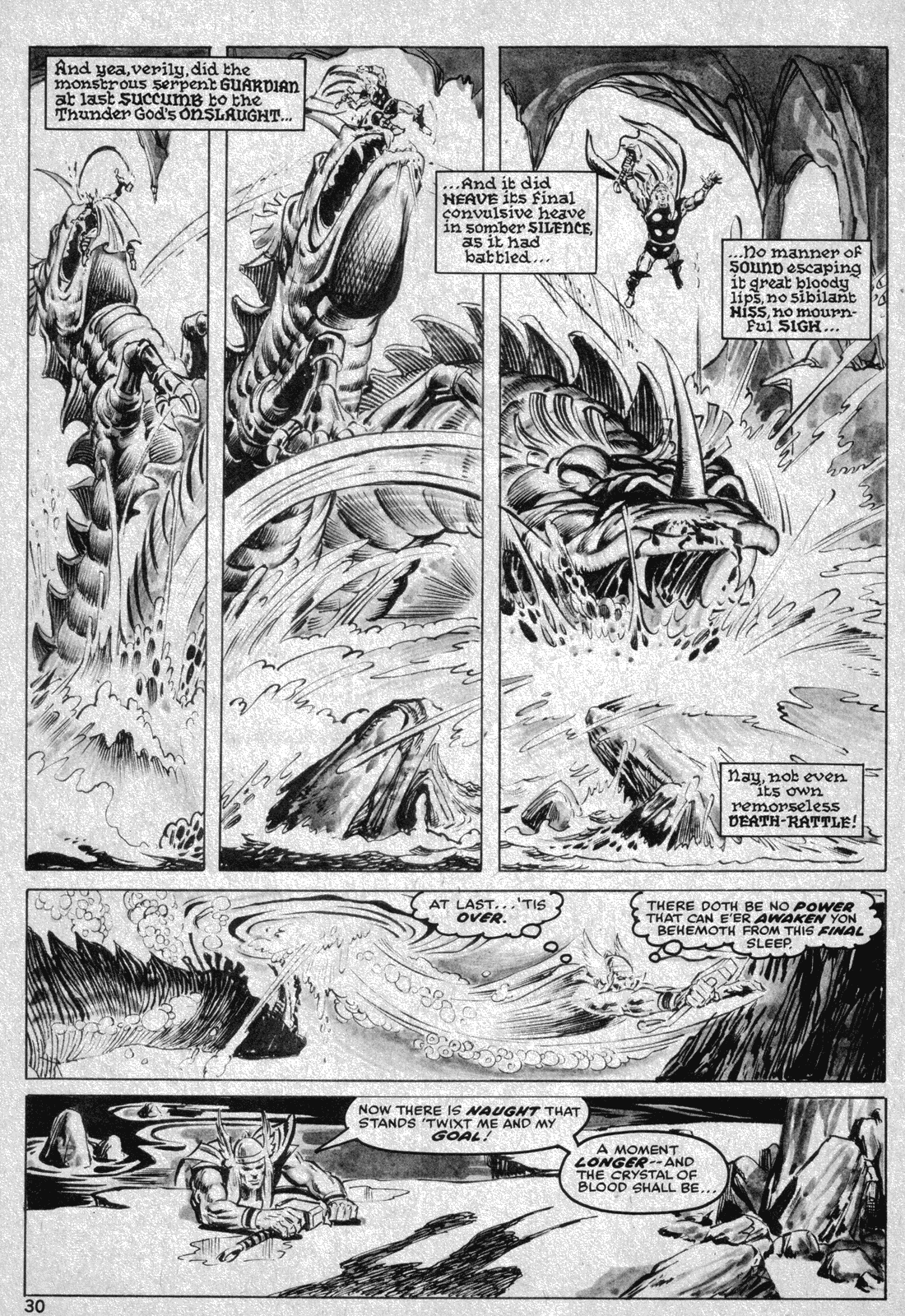 Thor finds that Loki has the Crystal of Blood and has gone all Gollum. he demonstrates its power and blinks Odin's servant out of existence. Thor evades Loki; but, can't stop the power, when one of the Titans knocks the crystal aside and grabs it. Thor hurls Mjolnir into it and it shatters and the cavern collapses. Thor rescues Loki and they go home and find it was all a test, which Thor passed. Hercules- Steve Reeves and Todd Armstrong have rolled up on an island, somewhere.... 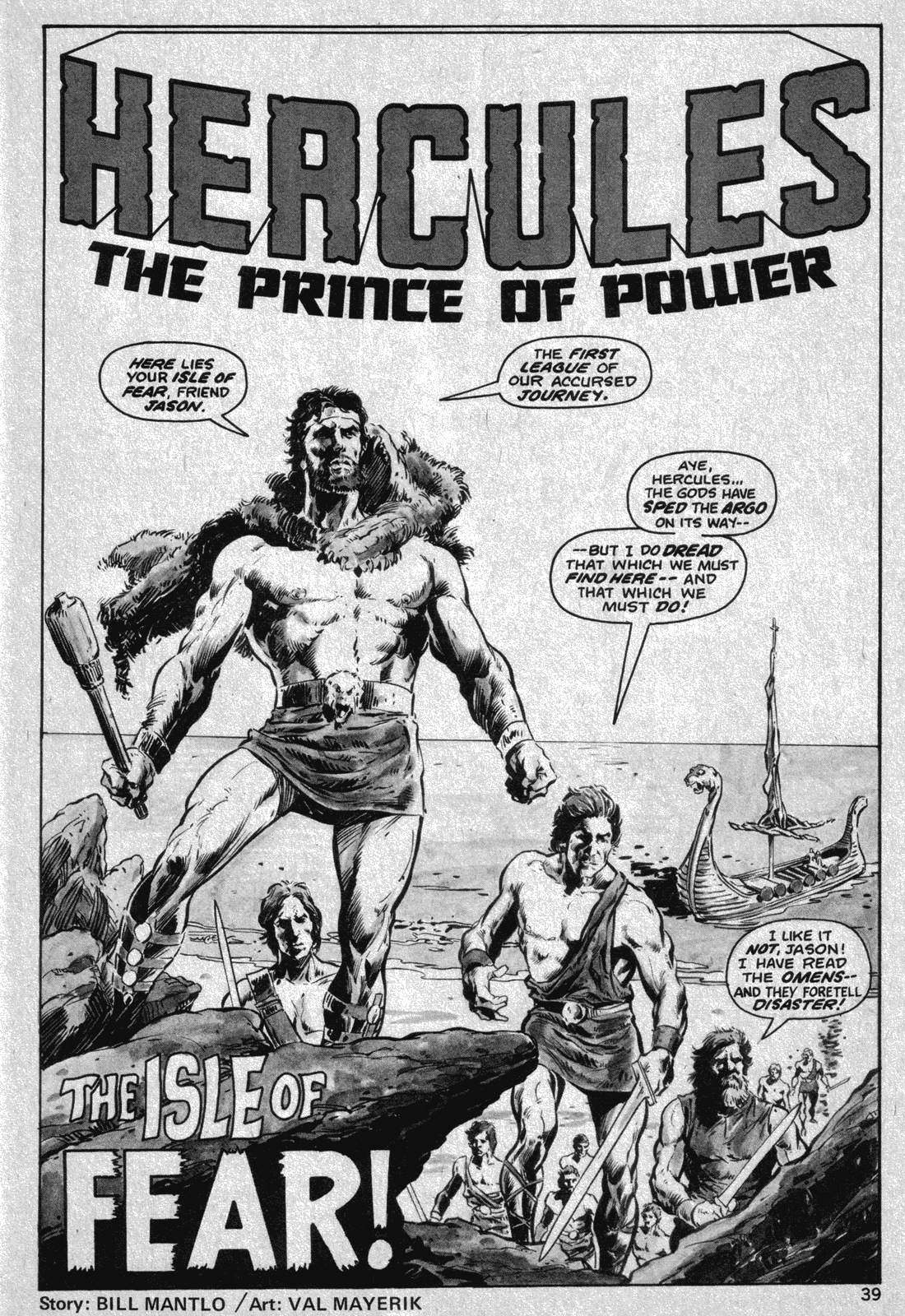 Herc flashes back to when he was hanging with Kreon, King of Pylos, when they were to be entertained. Enter Jason and Alceste, daughter of Kreon, to face a mad bull (not Alex Karras). Pylos is enraged that his daughter is down there. She twists her ankle and the bull is bearing down, when Herc jumps in and kills the bull. Steaks for everyone! Kreon wants Jason's head; but, Alceste says she asked him to teach her how to vault over bulls (sounds Freudian, to me). Kreon isn't having it, until herc intervenes and asked that Jason be sent on a quest to redeem himself. he has to get the Gold of the Gorgons. Which brings us back to the present and the Isle Of Fear. They get attacked by a griffin and Herc is back in flashback land. The Argo sails and runs into sea monsters and it is slice and dice time. Then, back to the Griffin, a vile, stinking, evil creature, who asks banal questions and goes "Oooooh!" Then he goes to commercial. Herc kills the beast and they head into a temple, where they meat up with Medusa, who dropkicks them and bodyslams them. Oh, wait, that's Madusa.  (Debrah Miceli, aka Madusa Miceli, aka Madusa, aka Alundra Blayze) Okay, Medusa attacks with her hair, then Karnak, Gorgon, Black Bolt Triton and Lockjaw show up...........No? That's the Inhumans? Okay, the lady with the snake coiffure turns up, turns Jason to stone, Herc fights, she is killed by an old Argonaut, Jason returns with the gold, finding Kreon about to marry off the daughter, gives him the gold, it's a viper, dead king, long live King Jason of Pylos. Um, not sure what version of the myths of Jason (or Hercules) that Bill Mantlo is reading; but, I think it has a few errors. Thoughts: The Thor story is pretty good and we almost get some Thunder Sex; but, despite a lack of Code, Marvel was still squeamish about that. Decent action, it all looks purty and ends as you would expect. Worth the wait? Not really. It reads like many a Thor comic and isn't that special; but, it's well done. At least it wasn't a graphic novel or something more expensive, with an average story. Hercules- Decent, unspectacular, Mantlo wasn't an A-student in mythology, judging by this. Jason went after the Golden Fleece to win his rightful kingdom, usurped when he was a baby. he faced harpies; but, no Gorgons. Hercules (Herakles, actually) did tag along. Medusa was slain by Perseus, as anyone who has seen the Clash of the Titans knows. (Pegasus was Bellerophon, though). This is okay; but, Ray Harryhausen did it better. Mayerik draws a very Steve Reeves Hercules. This needed Dan Vadis and the Ten Gladiators, if you ask me. or Joel and the Bots; take your pick. I wouldn't exactly say it was worth the wait; but, it was a decent issue. Wouldn't want a steady diet of this. I'd rather have some more Dominic Fortune; but, we are in for some John byrne on Star Lord; so, we got that going for us!
|
|
|
|
Post by codystarbuck on Jul 20, 2019 20:09:34 GMT -5
Marvel Graphic Novel #4 The New Mutants X-BABIES IN DA MANSION!!!!!!!!!!!!!!! Creative Team: Chris Claremont-(duh) writer, Bob McLeod (Chief!)-art (and western lawman in NYC), Tom Orzechowski-letters (mostly for his last name), Glynis Wein-colors, Weezy-edits, ego wrangler This launched the New Mutants series, the first new X-Men title (depending on how you view Champions or the Beast solo adventures). Was it worthy of a graphic album? Synopsis: Moira MacTaggert is oot and aboot, when her thoughts are interrupted by a wolf crashing down, who turns into a naked young woman, who knows her name. She recognizes it as Rahne Sinclair, a local lass. Well, then, the villagers show up with torches, shotguns and pitchforks. One of them has a bible and talks about the witch being possessed by the devil and other Hammer cliches. Moira tells him to "Stitch thas, Jammie!" and headbutts him!. Well, she should, but Claremont wouldn't write it. Maybe Grant Morrison. Och, ya ken?  Instead, Moira tells them off (boring!) and then carries off the girl. We switch to Brazil, where Roberto De Costa is about to score a goal, 'cause all anyone knows about Brazil is Pele. he gets fouled, a fight breaks out, and he gets all black and smokey. Everyone runs away, terrified, except his girl, Juliana, who is blond. "Cause, comics. Someone watches them on a monitor.  Next, we head to Kentucky, where everyone is a coal miner (or tobacco farmer) and they all head down into the mines. Young Sam Guthrie has a scholarship to college, but has to work to provide for his family, since Pa is gone and his pension don't stretch that fer. I'm surprised he is wearing shoes! Next thing you know, cave in! Sam gets panicky and bursts out the side of the mountain, saving Mr Lewis, and scared more than a jack rabbit with a hound dog yowlin fer 'em. They gather them up to go see Grannie for some doctorin'. The observer watches.  Danielle Moonstar sits up on a mountain, meditatin', when her pet cougar turns up to nuzzle her. He is startled by someone. it is Danni's grandfather, who tells her he is sending her to New York, to learn from a friend, Charles Xavier. Danni accidentally pulls out a vision of her grandfather being beaten to death by armored goons. That is the only reason she obeys her grandfather, so he can send her to the Whites. She will go and give up her culture, like wearing buckskins in the 20th century and keeping cougars as pets, because she is closer to nature.  The observer sees and we get a glimpse of him: Donald Pierce, of the Hellfire Club. The one who got gutted by Wolverine. He's got Sebastian Shaw's play toy, Tessa, all locked up in some mechanical bondage device and isn't listening to her safe word. Safe, Sane, Consensual, Donald; those are the rules! Danni is woken by something and tears out of the house to find her grandfather, dead, from a bludgeoning. She swears vengeance, like you do. Cut to the X-Mansion, where Xavier and Moira MacTaggert are scanning Karma, who first turned up in MTU 100, about 2 years before. She can possess people, 'cause that's what Karma means, to Claremont. She's also Vietnamese, not Indian; but, it's close enough. She gives a demonstration by possessing Moira, and before you can say "Thar's a moose loose aboot this hoose!" Rahne goes all Lon Chaney Jr. Xavier gets her to calm down, telepathically. Karma does an exposition dump, relating MTU 100 and then Xavier and Moira have a telepathic debate about reopening the school to help these young people, while they stand there and wonder why no one is talking. Xavier hires Karma to be his secretary, so she can support her siblings, which probably violates child labor laws. they get a letter about Grandfather's death and Xavier has a flashback to Nam, which sets off Karma. Danni is chased by armored goons, who kill her cougar...  Xavier and the X-Babies rescue her, and she cuts a promo on the white man. She's hurt, so they render first aid. Cut to Rio, where the girls are with Moira, when cops burst in to arrest them , under suspicion of being involved in kidnapping Roberto De Costa and Juliana Sandoval. Karma possesses the lead cop, they fake cuffing them (um, that's not how handcuffs work, guys. You can't put them on and not lock them. You can put them on loose enough to slip out of; but, they still have to latch). they break loose and bust some cop heads. They then hide in the crowd, in Rio (surprise it isn't perpetually Carnival). The spot Roberto and follow him, where we see him get tossed around by guys in Hellfire Club gimp suits, with reverse colors, when he Hulks out and goes all dark and deadly...  The gang shows up and Danni pulls out the image of their worst fear, Wolverine...  Juliana is killed trying to shelter Roberto. They leave. In Kentucky, Rahne and Xavier are traveling in a jeep, when Sam, in the normal colored Hellfire Club gimp suit, blasts into the jeep and pulls out Xavier. Rahne went Chaney and escaped. The Hellfire goons take Xavier away, after hitting a Stuckey's for a pecan log. Rahne follows them to their compound, switched to wolf/human hybrid form to jump the fence. Inside, Xavier gets to join Tessa in the dungeon room. The other Babies catch up with Rahne, when Sam turns up. Danni pulls the image of the cave in from his heads and he flips out and smashes away. The X-Babies attack and get to Xavier; but, blow it. Sam shows up and faces down Pierce; but, his powers fade. Xavier freezes him, thanks to the Babies disabling the psychic inhibitors. The kids free Xavier and Tessa,and go their seperate ways. tessa will deal with Pierce. Sam doesn't know which way to go and Roberto tells him. Back at the school, the X-Babies don their school uniforms, with Danni adding her own touches, then Sam shows up to join them.  Thoughts: Thoughts: I've never been a big fan of this or the first issue of the regular series and never read another. I heard it got better; but, I couldn't be bothered. This was never intended as a graphic novel. The series came about because Shooter wanted to get the X-men back to being a school for mutants and was going to return the original team. Weezy and Claremont concocted this to avoid it; but, only Karma was a pre-existing character. There was a hole in the graphic novel schedule, as neither Jim Starlin nor Mike friedrich had anything for it and Shooter and his people weren't able to drum up anything on their own. So, the first issue got an upgrade to graphic album to fill that hole. To answer my question from the beginning; no, this was not worthy of the format. There is absolutely nothing special about this story. It is average material, at best. It is filled with repeats of stuff from Kitty Pryde's first appearance, right down to the Hellfire Club angle. It's just a gathering of characters, none of whom are terribly compelling, here. All are pretty much stereotypes: repressed Scottish girl, soccer-playing Brazilian, coal miner from Kentucky, Native American in buckskins, etc... Granted, this is the debut for the team (apart from Karma); but, stereotypes aren't exactly a great way to start. Like I say, when I first read this, there was nothing about the characters that made me want to buy the regular series. The art from Bob McLeod is okay; but, not terribly impactful. McLeod ended up as part of the Superman team, at DC, a few years later and it was a better fit. This has a very Curt Swan vibe to the art. I love me some Curt Swan; but McLeod wasn't that seasoned a storyteller. Not yet, anyway. It all just seems kind of bland. It's a project that started with an editorial mandate that resulted in a series designed to prevent going one route, rather than carve its own. Sure, New Mutants got better; but, this isn't just a first issue of a series. It's a graphic novel that is supposed to represent something better than the norm, or with a higher aim in mind. This wasn't a concept in search of a format; it was a publishing schedule needing a substitute to stay on deadline. Why do you even have a publishing schedule for non-existent titles? Graphic albums should be specialty projects, published as needed. It's not another issue of a mid-level title. It basically said Marvel was more interested in churning out product, rather than producing quality, hoping that Marvel fans will lap it up, regardless. This was probably the first indication that the graphic novel line wasn't going to change the face of the industry. As we will see, this type of story will become more the norm for the line, rather than something experimental or something that is bigger than a standard comic book story. It's not a death knell, as we have some interesting things to come; but, it is a mis-step.
|
|
|
|
Post by codystarbuck on Jul 20, 2019 20:53:17 GMT -5
ps For the uninitiated, the Hellfire Club characters and their names were all based on actors and roles they played. Sebastian Shaw was based on Robert Shaw, Harry Leland was Orson Welles, who played Harry Lyme and whose best friend in Citizen Kane is Jed Leland. Donald Pierce, is Donald Sutherland, who played Hawkeye Pierce, in the film version of MASH. Jason Wyngarde (Mastermind) was based on Peter Wyngarde, who played Jason King, on ITV's Department S and Jason King adventure series. Wyngarde guest starred in the Avengers episode "A Touch of Brimstone," from which Claremont swiped the hellfire Club (and the Black Queen attire, as worn by Emma peel and transferred to Jean Grey). His character has two partners; one fat and one younger and thinner, setting up the basic visual.
In this story, Tessa is seen clamped into the chair inhibitor, with either stockings or thigh boots covering her legs, up to her thighs. After she is freed, she is drawn with bare legs from hip down, in an obvious mistake by McLeod.
|
|
|
|
Post by berkley on Jul 20, 2019 21:18:11 GMT -5
The Man-God cover is probably my favourite Earl Norem and I think the Thor cover was one of Ken Barr's best too. But the interior artwork was a let-down for me in both cases - never have liked Tony DeZuniga's style much. The Man-God story or character never appealed to me, as a variation on or precursor to Superman. Thor I surely would have loved if Starlin had done the complete artwork, at least going by a black and white Thor illustration featured as a frontispiece in this or some other issue of Marvel Preview:  |
|
|
|
Post by rberman on Jul 20, 2019 21:42:13 GMT -5
Here is Shaxper’s review of the New Mutants graphic novel. Here is mine. There’s some discussion of the publishing realities which caused this series to debut as a graphic novel. At the time, Claremont was riding high, and his name on an X-series was deemed enough of a draw to justify the choice. The All-New X-Men had started as broad stereotypes as well: gentle rural giant, ill-tempered runt, clothing-impaired nature queen, apparent demon spawn... hey wait. Those are the exact same character types found in the New Mutants! Sam = Peter Dani = Ororo (But with Thunderbird’s rebellion and rage against the White Man) Roberto = Logan Rahne = Kurt Hey, it worked once before, right?
|
|